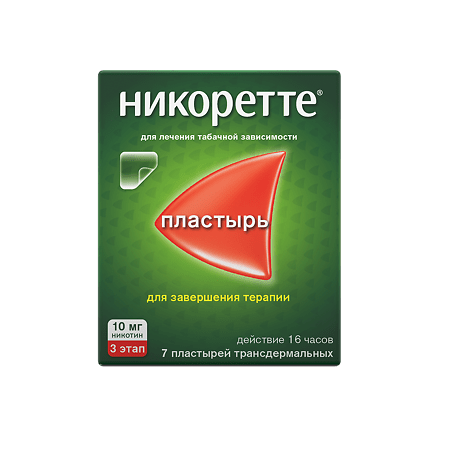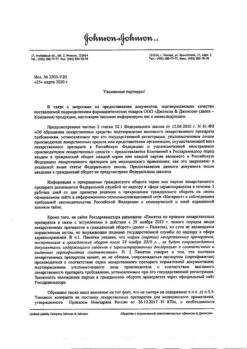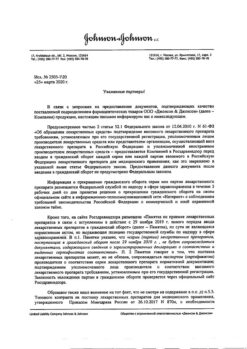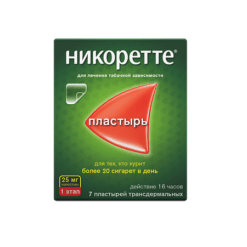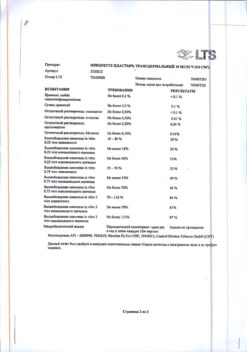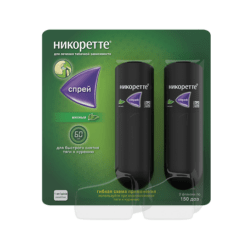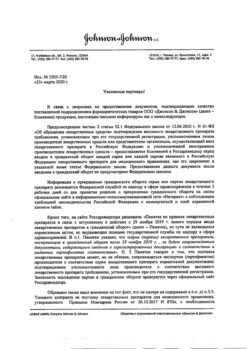No products in the cart.
Nicorette, 10 mg/16 h 7 pcs.
€47.62 €39.69
Description
Pharmacodynamics:
After abrupt smoking cessation in patients who have used tobacco-containing products daily for a long time, development of “withdrawal” syndrome is possible, which includes: dysphoria or depressed mood, insomnia, increased irritability, frustration or anger, anxiety, impaired concentration, anxiety or impatience, reduced heart rate, increased appetite or increased body weight. An important symptom of withdrawal syndrome is also a desire to smoke.
In the treatment of tobacco addiction nicotine replacement therapy reduces the number of cigarettes smoked, reduces the severity of withdrawal symptoms arising from complete smoking cessation in those who choose to quit smoking; facilitates temporary abstinence from smoking, and helps to reduce the number of cigarettes smoked by those who can not or do not want to give up smoking completely.
Pharmacokinetics:
Nicotine is slowly released from the Nicorette® patch and is continuously absorbed through the skin. The Nicorette® patch is designed to be used during waking hours, i.e. for approximately 16 hours, which coincides with the period of nicotine intake from smoking. This prevents sleep disturbances caused by nicotine intake during sleep. Absolute bioavailability exceeds 90%, regardless of where the patch is applied.
In the therapeutic range (10-25 mg/16 hours), the relationship between the plasma nicotine concentration and its dose is linear. The values of maximum nicotine concentrations (Cmax ) at different doses are shown below.
Nicotine dose (mg/16 hours) Cmax (ng/ml)
10 10
15 15 15.5
25 26.5
The maximum plasma nicotine concentrations calculated from the model correspond to those measured: 11 ng/mL for the 10 mg transdermal patch and 25 ng/mL for 25 mg. The maximum plasma concentration value obtained by interpolation when using the 15 mg transdermal patch was 16 ng/ml.
The time of reaching maximum plasma concentration (tmax) is approximately 9 hours and is created in the afternoon or evening, when the risk of relapse is maximum.
The volume of distribution after intravenous administration of nicotine is approximately 2-3 L/kg and its half-life is approximately 2-3 hours. Nicotine is primarily excreted by the liver, the average plasma clearance is about 70 liters/hour. Nicotine is also metabolized in the kidneys and lungs. More than 20 metabolites of nicotine have been identified, the activity of which is inferior to that of the original substance.
The binding of nicotine to plasma proteins is less than 5%.
The main metabolite of nicotine – cotinine – has a half-life of 15-20 hours and is found in plasma at a concentration 10 times higher than that of nicotine.
The main metabolites of nicotine excreted in the urine are cotinine (12% of the administered dose) and trans-3-hydroxy-cotinine (37% of the administered dose).
About 10% of nicotine is excreted unchanged in the urine. At high filtration rate and urine pH below 5, the amount of nicotine excreted unchanged in the urine may reach 30%.
Progression of renal failure may be accompanied by decreased total nicotine clearance. Smokers with concomitant chronic renal failure treated with hemodialysis have increased plasma nicotine concentration.
Pharmacokinetics of nicotine in mild hepatic failure (5 points on the Child-Pugh scale) does not change, in moderate hepatic failure (7 points on the Child-Pugh scale) nicotine clearance is reduced.
A slight decrease in total nicotine clearance has been noted in healthy elderly patients, which, however, does not require dose adjustment.
Plasma nicotine concentration increases with the three types of transdermal patches in proportion to the dose.
No differences in nicotine pharmacokinetics were observed in men and women.
Indications
Indications
For the treatment of tobacco addiction by reducing the need for nicotine, relieving the “withdrawal” symptoms that occur when quitting smoking in patients who have the appropriate motivation.
Pharmacological effect
Pharmacological effect
Pharmacodynamics:
After abrupt cessation of smoking, patients who have used tobacco-containing products daily for a long time may develop a withdrawal syndrome, which includes: dysphoria or depressed mood, insomnia, increased irritability, dissatisfaction or anger, anxiety, difficulty concentrating, restlessness or impatience, decreased heart rate, increased appetite, or weight gain. An important symptom of withdrawal syndrome is also the desire to smoke.
In the treatment of tobacco addiction, nicotine replacement therapy reduces the need for the number of cigarettes smoked, reduces the severity of withdrawal symptoms that occur with complete cessation of smoking in those who decide to quit smoking; facilitates temporary abstinence from smoking, and also helps to reduce the number of cigarettes smoked for those who cannot or do not want to completely quit smoking.
Pharmacokinetics:
Nicotine is slowly released from the Nicorette® patch and is continuously absorbed through the skin. The Nicorette® patch is intended for use during waking hours, i.e. for approximately 16 hours, which coincides with the period of nicotine intake during smoking. This allows you to avoid sleep disturbances caused by nicotine intake during sleep. Absolute bioavailability exceeds 90%, regardless of where the patch is applied.
In the therapeutic range (10–25 mg/16 hours), the relationship between the concentration of nicotine in the blood plasma and its dose is linear. Below are the maximum nicotine concentrations (Cmax) when using different doses.
Nicotine dose (mg/16 hours) Cmax (ng/ml)
10 10
15 15.5
25 26.5
The maximum concentrations of nicotine in blood plasma calculated by the model correspond to those measured: 11 ng/ml – when using a 10 mg transdermal patch and 25 ng/ml – for 25 mg. The value of the maximum concentration in blood plasma obtained by interpolation when using a 15 mg transdermal patch was 16 ng/ml.
The time to reach maximum plasma concentration (tmax) is approximately 9 hours and occurs in the afternoon or evening, when the risk of relapse is greatest.
The volume of distribution after intravenous administration of nicotine is approximately 2–3 L/kg, and its half-life is approximately 2–3 hours. Nicotine is primarily excreted by the liver, with an average plasma clearance of about 70 l/hour. Nicotine is also metabolized in the kidneys and lungs. More than 20 nicotine metabolites have been identified, the activity of which is inferior to that of the parent substance.
The binding of nicotine to plasma proteins is less than 5%. In this regard, disturbances in the binding of nicotine during the simultaneous use of other drugs or changes in plasma protein levels in various diseases should not have a significant effect on the kinetics of nicotine.
The main metabolite of nicotine, cotinine, has a half-life of 15–20 hours and is found in the blood plasma at a concentration 10 times higher than that of nicotine.
The main nicotine metabolites excreted in the urine are cotinine (12% of the administered dose) and trans-3-hydroxy-cotinine (37% of the administered dose).
Approximately 10% of nicotine is excreted unchanged in urine. At high filtration rates and urine pH below 5, the amount of nicotine excreted unchanged in urine can reach 30%.
Progression of renal failure may be accompanied by a decrease in overall nicotine clearance. In smokers with concomitant chronic renal failure treated with hemodialysis, an increase in plasma nicotine concentrations was observed.
The pharmacokinetics of nicotine in mild liver failure (5 points on the Child-Pugh scale) does not change; in moderate liver failure (7 points on the Child-Pugh scale), nicotine clearance decreases.
A slight decrease in the total clearance of nicotine was observed in healthy elderly patients, which, however, does not require dose adjustment.
The concentration of nicotine in the blood plasma increases with the use of three types of transdermal patches in proportion to the dose.
There were no differences in the pharmacokinetics of nicotine between men and women.
Special instructions
Special instructions
The use of Nicorette® is associated with less risk than smoking.
Nicorette® transdermal patch should be removed before MRI (magnetic resonance imaging) to avoid burns.
Danger for small children
Doses of nicotine that are easily tolerated by adult and teenage smokers can cause severe toxicity in children, which can lead to death. It is important not to leave preparations containing nicotine unattended, as this may lead to their misuse and ingestion by children (see section “Overdose”).
Formation of dependence
Dependence on the drug may develop, but it is less dangerous to health and more easily overcome than addiction to smoking.
Quitting smoking
Polycyclic aromatic hydrocarbons contained in tobacco smoke induce the metabolism of drugs metabolized by the CYP1A2 isoenzyme (and possibly CYP1A1). Quitting smoking can cause a slowdown in metabolism and, as a result, an increase in the concentration of these drugs in the blood. This has potential clinical implications for drugs with a narrow therapeutic index, such as theophylline, tacrine, clozapine and ropinirole.
Plasma concentrations of other drugs that are partially metabolized by CYP1A2, such as imipramine, olanzapine, clomipramine and fluvoxamine, may also increase after smoking cessation, although there are no data to support this hypothesis and the possible clinical significance of this effect is unknown.
Limited evidence suggests that smoking may induce the metabolism of flecainide and pentazocine.
After use, the patch should be folded with the adhesive side inward and disposed of out of the reach of children.
Warnings and precautions for combination therapy of Nicorette® transdermal patch with chewable gum/sublingual tablets/topical spray are the same as the warnings and precautions for use of either drug alone.
If the medicine has become unusable or has expired, do not throw it into wastewater or onto the street! Place the medication in a bag and place it in the trash. These measures will help protect the environment!
Active ingredient
Active ingredient
Nicotine
Composition
Composition
Nicotine base:
Active ingredient:
nicotine – 15.75 mg;
Excipients: triglycerides (average chain length) – 18.27 mg, copolymer of basic butyl methacrylate – 14.58 mg, polyethylene terephthalate film 19 μm (can be varnished on one side) – carrier of the layer containing the active substance.
Acrylate base: acrylic adhesive solution – 123.84 mg, potassium hydroxide – 0.70 mg, croscarmellose sodium – 5.00 mg, aluminum acetylacetonate – 0.06 mg, polyethylene terephthalate film 100 μm, aluminized on one side and siliconized on both sides – carrier, performs a protective function adhesive layer (removable backing), discarded before use.
Pregnancy
Pregnancy
Smoking during pregnancy is associated with risks such as intrauterine growth restriction, premature birth, or stillbirth. Smoking cessation is the single most effective intervention for improving the health of both the pregnant woman and her baby. Quitting smoking early is the best option.
Nicotine penetrates the placental barrier and affects the respiratory activity and blood circulation of the fetus. The effect on blood circulation is dose-dependent. Smoking can have serious adverse effects on the fetus and newborn and should therefore be stopped. Therefore, ideally, smoking cessation during pregnancy should be carried out without nicotine replacement therapy.
The risk to the fetus with Nicorette® has not been fully studied. However, the benefits of nicotine replacement therapy in pregnant women who cannot quit smoking without such treatment far outweigh the risks of continuing smoking. The Nicorette® patch should only be used in highly dependent pregnant women after consultation with a physician.
Nicotine passes into breast milk in quantities that may affect the baby, even when used in therapeutic doses. Therefore, you should refrain from using the Nicorette® patch during breastfeeding. If you are unable to quit smoking, use of the drug should only be started after consultation with your doctor.
Smoking increases the risk of infertility in men and women. In vitro studies have shown that nicotine negatively affects sperm quality in men.
Contraindications
Contraindications
Hypersensitivity to nicotine or other components of the drug.
Side Effects
Side Effects
Regardless of the drug used to treat tobacco dependence, some symptoms may be due to nicotine withdrawal due to smoking cessation.
These include: dysphoria or depressed mood; insomnia; irritability, dissatisfaction or anger; anxiety; difficulty concentrating; restlessness or impatience; decreased heart rate; increased appetite or weight gain; dizziness or lightheadedness; cough, constipation and bleeding gums.
The incidence of canker sores, cough, and nasopharyngitis may also increase after smoking cessation. A cause-and-effect relationship has not been established.
Nicotine craving, considered a clinically significant symptom, is an important manifestation of nicotine withdrawal after smoking cessation.
Nicorette® patch may cause nicotine-related adverse reactions similar to those observed with other nicotine-containing products. Most adverse reactions reported by patients occur in the early phase of therapy and are predominantly dose-dependent.
Approximately 20% of patients develop mild local skin reactions during the first weeks of therapy.
Allergic reactions (including anaphylactic reactions) may rarely occur in susceptible individuals.
Interaction
Interaction
There are no clear clinically significant interactions between nicotine replacement therapy and other drugs. However, theoretically, nicotine may enhance the hemodynamic effects of adenosine, i.e., lead to an increase in blood pressure and heart rate, and also enhance the pain response (angina-type chest pain) provoked by the administration of adenosine.
Overdose
Overdose
Excessive nicotine intake from replacement therapy and/or smoking may cause overdose symptoms.
Symptoms of nicotine overdose may occur in patients with low nicotine intake prior to treatment or when using multiple nicotine sources simultaneously.
In case of an overdose, the same symptoms are observed as in acute nicotine poisoning, namely: nausea, vomiting, increased salivation, abdominal pain, diarrhea, sweating, headache, dizziness, hearing impairment and severe general weakness. When using high doses, these symptoms may be followed by the following symptoms: decreased blood pressure, weak and irregular pulse, difficulty breathing, loss of strength, collapse and generalized convulsions.
Nicotine in doses tolerated by adult smokers can cause symptoms of severe poisoning in children and even lead to death. Suspicion of nicotine poisoning in children should be regarded as an emergency condition requiring immediate hospitalization.
Treatment of overdose: nicotine use should be stopped immediately and symptomatic treatment should be prescribed. It is necessary to remove the patch and rinse the area where the patch is applied with water. Activated carbon reduces the absorption of nicotine in the gastrointestinal tract.
The minimum lethal dose for an acute overdose for a non-smoking adult is 40–60 mg of nicotine.
Storage conditions
Storage conditions
Store at a temperature not exceeding 25 °C.
Keep out of the reach of children.
Shelf life
Shelf life
3 years
Manufacturer
Manufacturer
LTS Lohmann Therapy-Systeme AG, Germany
Additional information
| Shelf life | 3 years |
|---|---|
| Conditions of storage | Store at a temperature not exceeding 25 ° C. Keep out of reach of children. |
| Manufacturer | McNeil AB, Sweden |
| Medication form | Transdermal Therapy System |
| Brand | McNeil AB |
Other forms…
Related products
Buy Nicorette, 10 mg/16 h 7 pcs. with delivery to USA, UK, Europe and over 120 other countries.

